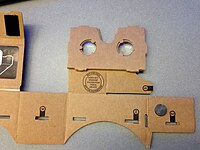Google Cardboard
 | |
 第二代Google Cardboard | |
| 研發商 | |
|---|---|
| 製造商 | Google、第三方公司 |
| 類型 | DIY虛擬實境穿戴式裝置 |
| 發佈日期 | 2014年6月25日 |
| 出貨台數 | 1000萬個 |
| 作業系統 | Android、IOS |
| 後繼機種 | Daydream |
| 網站 | 官方網站 |
Google Cardboard是Google所開發、與智能電話配合使用的虛擬現實頭戴式顯示器。該平台以其摺疊式紙板頭盔命名,旨在以廉價成本,激發對VR應用的興趣和發展[1][2]。按照Google發佈的規範,用戶既可以利用廉價簡易的元件自行製作頭盔,或購買預先做好的頭盔。要使用平台,用戶須在手機上執行Cardboard相容的應用,將手機置於頭盔後端,透過鏡片觀看內容[3]。
該平台由巴黎Google藝術文化學院工程師大衛·科玆(David Coz)和達米恩·亨利(Damien Henry)利用他們20%「創意休息時間」(Innovation Time Off)開發[4],於2014年Google I/O開發者大會上亮相,被派發給現場所有觀眾。Cardboard的軟件開發套件(SDK)向Android和iOS作業系統開發。SDK的VR View允許開發者嵌入網絡及他們流動應用中的VR內容。
到2017年3月,Cardboard發貨量超過1000萬個,1.6億個Cardboard應用程式上線。乘着Cardboard平台的成功,Google在2016年的Google I/O上宣佈了增強VR平台Daydream。
2019年,Cardboard開源。2021年3月,Google停售Cardboard[5]。
組裝和操作[編輯]
Google Cardboard頭盔利用簡單低廉的組件製作。頭盔規格由Google設計,零件清單、原理圖和組裝說明書在其網站上免費提供,讓人們從現成的零件中組裝Cardboard。預先做好的頭盔只能從第三方供應商取得,直到2016年2月,Google開始透過Google Store銷售自家出產的頭盔[6]。
組裝Cardboard頭盔的零件有一塊切割成精確形狀的紙板、45mm焦距透鏡、磁鐵或電容式感應膠帶、尼龍搭扣(如維克羅)、橡皮圈和可選的近場通訊標籤。Google為大規模製造提供額外的建議,基於這些計劃的預組裝套件源於多個供應商,成本不到5美元[7],這些供應商也製作各種Cardboard。
組件裝好後,將智能電話插入裝置背部,用所選的緊固裝備固定。相容Google Cardboard的應用程式將智能電話顯示的畫面分成兩個,每個眼睛一個,同時對每個畫面進行桶形失真,抵消鏡頭的枕形失真[8],形成視野廣闊的立體(3D)圖像。
Cardboard首個版本貼合5.7英寸屏的手機,利用磁鐵作為輸入按鈕,需要用到手機的羅盤感測器。更新版設計於2015年Google I/O發佈,磁貼開關換成導電杆,在手機熒幕上觸發輕觸事件,更好地相容各種裝置。
軟件[編輯]
Google提供三套開發Cardboard應用的軟件開發套件,一套用Java供Android作業系統使用,一套用C♯供Unity遊戲引擎使用,一套供iOS作業系統使用[9]。最初僅支援Android,後來Google在2015年5月的Google I/O會議上宣佈iOS支援Unity外掛程式[10]。Cardboard支援的第三方應用在Google Play商店[11]和iOS的上App Store上線。除了原生的Cardboard應用,Google Chrome的VR實驗利用WebGL實現,包括iPhone在內的支援WebGL的手機也可以執行Google的網頁實驗[12][13]。在2015年Google I/O上,iOS的Google Cardboard演示應用程式介面發佈[14]。2016年1月,Google宣佈,軟件開發套件將支援空間音頻,這種虛擬現實效果能模擬3D空間中出自聽眾頭部外面任何地方的音頻[15][16]。
2016年3月,Google發佈Cardboard SDK擴充應用VR View,允許開發者嵌入網頁或流動應用程式中的360度VR內容,適用於桌面、Android和iOS[17]。VR內容發佈網頁的Javascript和HTML代碼開源,在GitHub上公佈,開發者可自行寄存內容[18]。
衍生品[編輯]
Jump[編輯]
Jump是Google開發的虛擬現實影片製作生態系統,於2015年5月28日在Google I/O大會上公佈。如同Google對待Cardboard頭盔一樣,Google對Jump也開發了由16台攝像放像機圓狀陣列構成的樣式,並和公眾發佈[19]。GoPro和Google合作,利用自家攝像放像機搭建陣列[20],但Jump系列理論上支援任何攝像放像機[19]。一旦拍好畫面,VR影片將由Jump的後端軟件「組譯器」編譯。組譯器使用電腦攝影和「電腦視覺」重建場景,產生數千個中間視點[19]。通過Jump拍攝的成片可配合Cardboard頭盔透過YouTube的立體VR模式觀看[19]。
Expeditions[編輯]
Expeditions計劃提供透過Google Cardboard頭盔的VR課堂體驗,讓教育人士帶着他們的學生進行虛擬的實地考察[21]。該計劃也在2015年Google I/O上公佈,計劃於2015年秋季執行[22]。每個教學套件包內含30個同步的Cardboard頭盔和智能電話,以及一個供充當精靈的老師使用的平板電腦[23]。有意將計劃帶到學校的教師可線上註冊[24]。CNET稱Cardboard是「首個面向兒童的虛擬現實平台」[25]。到2016年5月,超過100萬學生透過該計劃進行VR實地考察[26]。
合作與推廣[編輯]
2014年11月,富豪發佈了Volvo牌Cardboard眼睛和Android應用「Volvo Reality」,讓用戶探索XC90[27]。2015年2月,玩具製造商美泰爾聯合Google宣佈立體頭盔View-Master的VR版。頭盔Android版於2015年秋季發佈,iOS和Windows智能電話隨後發佈[28]。
Google也和LG電子合作,為LG G3客製化Cardboard頭盔「VR for G3」。該免費配件於2015年2月發佈,在某些國家或地區連同新的G3機型派發,被視為三星Gear VR配件的有力競爭者[29]。
2015年11月8日,《紐約時報》面向所有家庭訂閱戶派發Google Cardboard。讀者用智能電話下載「NYT VR」應用程式,可享受沉浸式VR環境的新聞閱讀體驗[30]。
2015年12月,為配合《星球大戰:原力覺醒》的宣傳,Google在Google Store和Verizon免費推出三款《星球大戰》主題的Cardboard頭盔[31]。
2016年科切拉音樂節的持票者會在歡迎禮包中獲得Google Cardboard創意的VR紙板頭盔,該頭盔配合「Coachella VR」流動應用使用。組委會聯合Vantage.tv提供音樂節的VR內容,如往屆活動的360度全景照、2016年活動地點的虛擬遊覽、採訪和表演[32]。
評價[編輯]
2016年1月27日,Google宣佈平台第19個月,Cardboard發貨量超過500萬個,上架的相容應用超過1000個,安裝次數達2500多萬次。公司介紹,期間用戶觀看了超過35萬小時的YouTube VR影片,50萬名學生通過Expeditions計劃進行VR實地考察[33][34]。到2017年3月,發貨量突破1000萬,應用程式下載量超過1.6億次[35]。
Cardboard的成功說服Google開發更先進的虛擬現實硬件並任命新的虛擬現實主管[36]。2016年5月18日,Google在I/O大會上公佈了名為Daydream的增強型VR平台[37]。
參見[編輯]
- Google眼鏡,另一個Google公司的產品,將可以在眼前顯示資料
- Oculus Rift,虛擬實境(VR)計劃,近期被Facebook收購
- 三星Gear VR,三星電子與Oculus VR合作的產品
- PlayStation VR,索尼的虛擬實境計劃
- Virtual Boy,任天堂的1995年桌上型3D遊戲機
- HTC Vive,宏達國際電子(HTC)和維爾福公司(Valve Corporation)合作的虛擬實境產品
參考資料[編輯]
- ^ Pierce, David. Google Cardboard is VR's Gateway Drug. Wired. 2015-05-28 [2015-06-17]. (原始內容存檔於2020-11-08).
- ^ Branstetter, Ben. Cardboard is everything Google Glass never was. kernelmag.dailydot.com. 2015-06-28 [2015-06-28]. (原始內容存檔於2015-06-28).
- ^ Pierce, David. Inside Google’s Plan to Make VR Amazing for Absolutely, Positively Everyone. Wired Magazine. 2016-04-14 [2016-04-14]. (原始內容存檔於2017-06-24) (美國英語).
- ^ Statt, Nick. Facebook has Oculus, Google has Cardboard. CNET. 2014-06-25 [2014-08-19]. (原始內容存檔於2020-11-30).
- ^ Google Cardboard VR 正式停售. [2021-03-04]. (原始內容存檔於2021-03-10).
- ^ Fingas, Jon. Google starts selling Cardboard VR viewers through its store. Engadget. AOL. 2016-02-29 [2016-04-03]. (原始內容存檔於2016-03-01).
- ^ Dougherty, Conor. Google Intensifies Focus on its Cardboard Virtual Reality Device. New York Times. 2015-05-28 [2015-06-17]. (原始內容存檔於2020-11-08).
- ^ Unity Reference: Google Cardboard. developers.google.com. [2015-06-03]. (原始內容存檔於2015-06-17).
...specifies whether you want the values as seen through the Cardboard lenses (Distorted) or as if no lenses were present (Undistorted). ... When VR Mode is enabled, stereo cameras render side-by-side to this target automatically. Each frame, the result is corrected for distortion and then displayed. ... Implements the same barrel distortion that is performed by the native code.
- ^ Google Cardboard – Google. Google. [2015-06-02]. (原始內容存檔於2021-01-27).
- ^ Tarantola, Andrew. Google Cardboard now works on iOS. Engadget. 2015-05-28 [2015-06-02]. (原始內容存檔於2019-04-09).
- ^ Broida, Rick. Five more apps that work with Google Cardboard: Games, flight sims, movie players, and more, all great fits for your Google VR headset.. CNET. 2014-07-17 [2014-08-19]. (原始內容存檔於2019-02-17).
- ^ Virtual Reality. Chrome Experiments. [2014-08-19]. (原始內容存檔於2014-10-04).
- ^ Johnson, Dave. Google Cardboard works on the iPhone, too. CBS News. 2014-08-18 [2014-08-19]. (原始內容存檔於2020-12-02).
- ^ Lee, Nicole. Google Cardboard VR for iPhone hands-on. Engadget. 2015-05-28 [2015-06-02]. (原始內容存檔於2019-02-04).
- ^ Eadicicco, Lisa. Google's Cheap Virtual Reality Headset Is About to Get Better. Time.com. Time Inc. 2016-01-14 [2016-01-17]. (原始內容存檔於2016-01-16).
- ^ Martz, Nathan. Spatial audio comes to the Cardboard SDK. Google Developers Blog. 2016-01-13 [2016-01-17]. (原始內容存檔於2016-02-27).
- ^ Vincent, James. Google's new VR View tool allows easy embedding of 360-degree content. The Verge. Vox Media. 2016-03-31 [2016-04-03]. (原始內容存檔於2020-11-08).
- ^ Martz, Nathan. Introducing VR view: embed immersive content into your apps and websites. Google Developers Blog. 2016-03-30 [2016-04-03]. (原始內容存檔於2020-11-25).
- ^ 19.0 19.1 19.2 19.3 O'Kane, Sean. Google Jump is an entire ecosystem for virtual reality film-making. The Verge. Vox Media. 2015-05-28 [2015-06-09]. (原始內容存檔於2020-11-08).
- ^ Duino, Justin. We took a look at the GoPro Google Jump camera array. Android Central. Mobile Nations. 2015-05-29 [2015-06-09]. (原始內容存檔於2020-08-07).
- ^ Etherington, Darrell. Google Launches ‘Expeditions,’ An App For Shared Virtual School Field Trips. TechCrunch. AOL. 2015-05-28 [2015-06-12]. (原始內容存檔於2021-01-24).
- ^ Novet, Jordan. Google announces Cardboard Expeditions to let teachers take classes on field trips. VentureBeat. 2015-05-28 [2015-06-12]. (原始內容存檔於2020-11-08).
- ^ Lee, Nicole. Google makes its case for VR by reinventing the field trip. Engadget. AOL. 2015-06-04 [2015-06-12]. (原始內容存檔於2019-03-27).
- ^ Robertson, Adi. Google has a new Cardboard headset, and it supports iPhones. The Verge. Vox Media. 2015-05-28 [2015-06-12]. (原始內容存檔於2020-11-08).
- ^ Stein, Scott. Cardboard for kids: Google's bet on the future of VR is children. CNET. 2015-06-02 [2015-06-28]. (原始內容存檔於2020-11-08).
- ^ Novet, Jordan. Google is working with IMAX and Yi Technology to build Jump-ready VR camera rigs. VentureBeat. 2016-05-19 [2016-07-18]. (原始內容存檔於2020-11-08).
- ^ Ziegler, Chris. Volvo is using Google Cardboard to get people inside its new SUV. The Verge. Vox Media. 2014-11-13 [2015-06-02]. (原始內容存檔於2020-11-12).
- ^ Baig, Edward C. View-Master rides Google Cardboard into virtual reality. USA Today. 2015-02-13 [2015-05-30]. (原始內容存檔於2020-09-06).
- ^ For LG's G3, virtual reality is just a bundle away. CNET. [2015-09-25]. (原始內容存檔於2020-11-29).
- ^ NYT VR: How to Experience a New Form of Storytelling From The Times. New York Times. 2015-11-05 [2015-11-07]. (原始內容存檔於2017-07-29).
- ^ Olanoff, Drew. Get a Free Star Wars Edition Google Cardboard. TechCrunch. 2015-12-11 [2015-12-12]. (原始內容存檔於2020-11-24).
- ^ Brennan, Collin. Coachella 2016 will be broadcast in virtual reality. Consequence of Sound. 2016-03-10 [2016-03-11]. (原始內容存檔於2016-03-11).
- ^ Dipane, Jared. Google: 5 million Cardboard viewers shipped, 25 million VR apps downloaded. Android Central. Mobile Nations. 2016-01-27 [2016-01-27]. (原始內容存檔於2016-07-12).
- ^ Singleton, Micah. Google has shipped over 5 million Cardboard headsets. The Verge. Vox Media. 2016-01-27 [2016-01-27]. (原始內容存檔於2021-01-27).
- ^ Jonnalagadda, Harish. Google has shipped 10 million Cardboard VR headsets since 2014. Android Central. Mobile Nations. 2017-03-01 [2017-03-01]. (原始內容存檔於2020-08-07).
- ^ Nicas, Jack. Alphabet Appoints New Virtual-Reality Chief. Wall Street Journal. 2016-01-12 [2016-02-12]. (原始內容存檔於2020-08-01).
- ^ Robertson, Adi; Miller, Ross. Daydream is Google’s Android-powered VR platform. The Verge. Vox Media. 2016-05-18 [2016-05-18]. (原始內容存檔於2020-12-22).
外部連結[編輯]
| 維基共享資源上的相關多媒體資源:Google Cardboard |
- 官方網站
- Google Play Store上的Cardboard官方應用Andorid版 (頁面存檔備份,存於互聯網檔案館)
- Google Play Store上的Cardboard官方應用iOS版 (頁面存檔備份,存於互聯網檔案館)
- Google Play的Cardboard Design Lab應用,演示VR設計準則 (頁面存檔備份,存於互聯網檔案館)
| ||||||||||||||||||||||||||||||||||||||||||||||||||||||||||||||||||||||||||||||||||||||||||||||
| |||||||||||||||||||||||||||||||||||||||||||||||||||||||||||||||||||||||||||||||||||||||||||||||||||||||||||||||||||||||
| |||||||||||||||||||||||||||||||||||||||||||||||||||||




